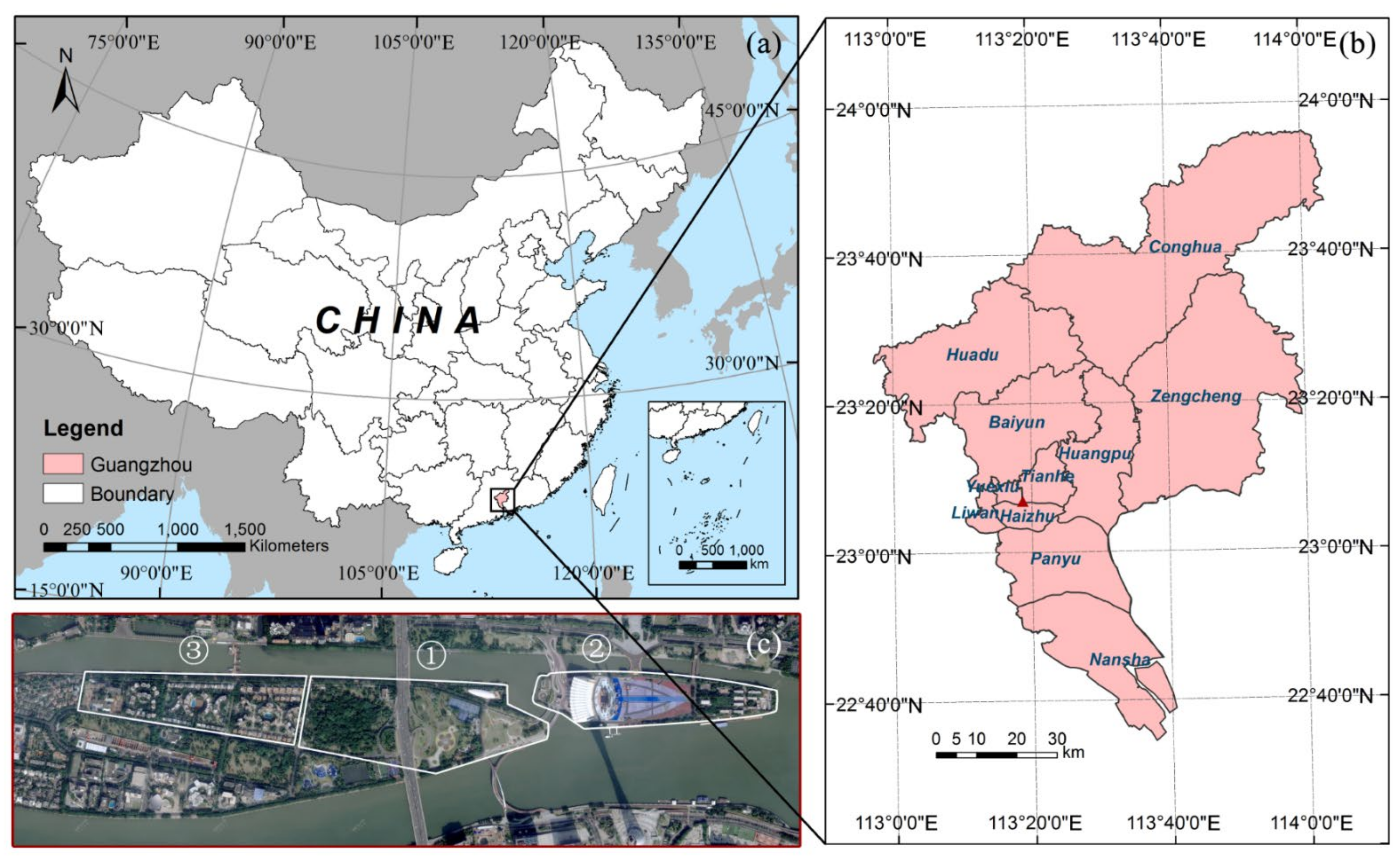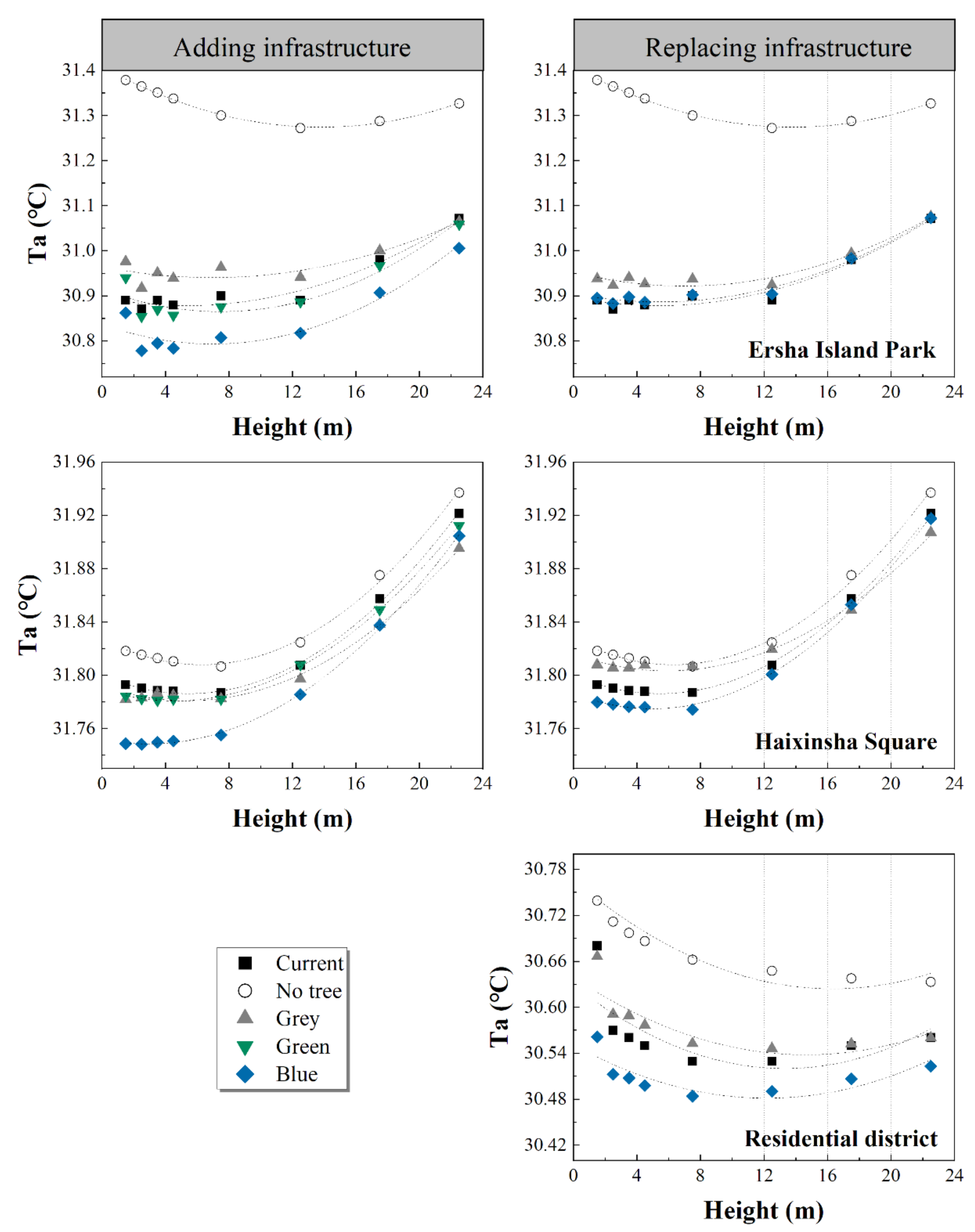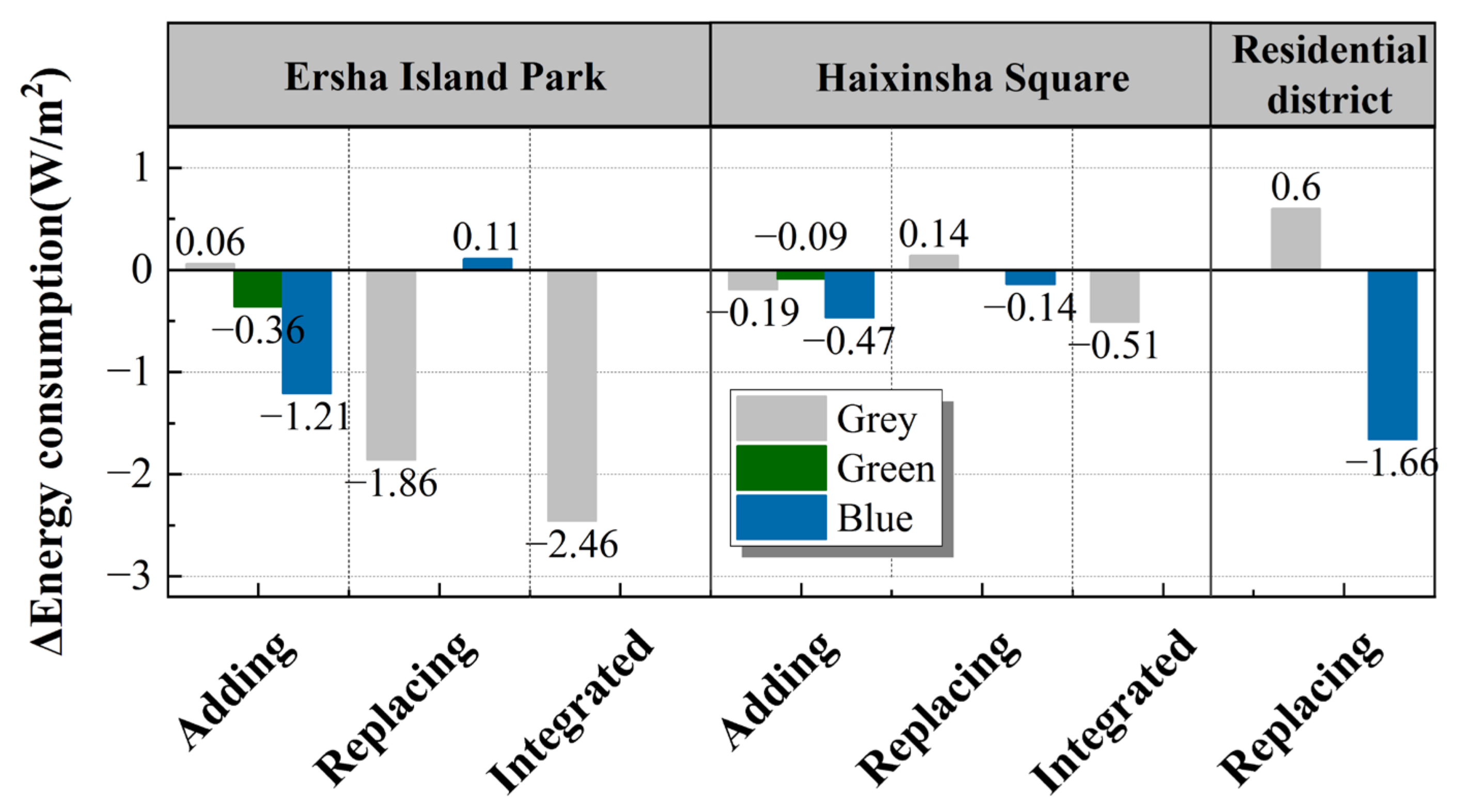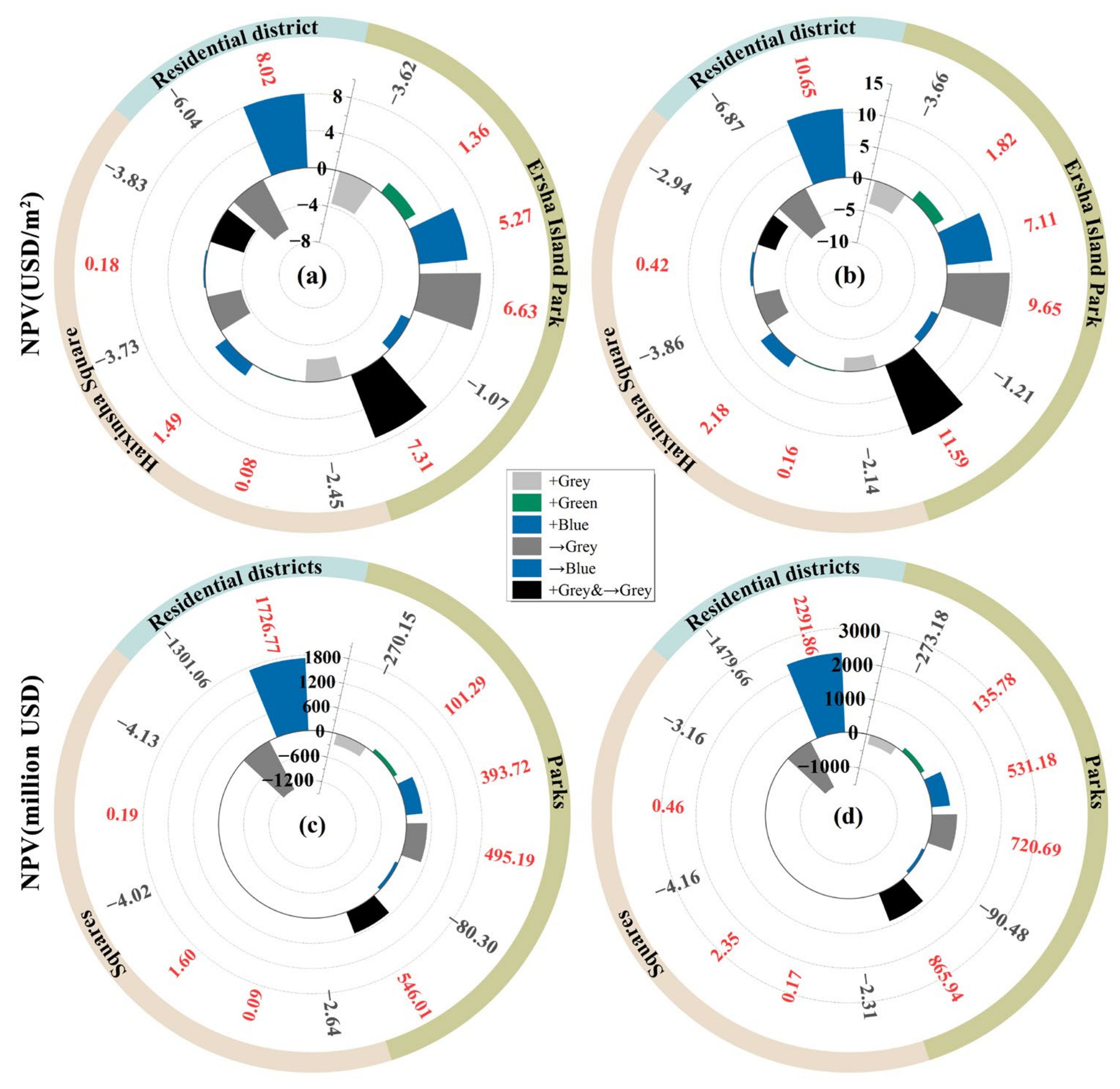Evaluating Trade-Offs in Ecosystem Services for Blue–Green–Grey Infrastructure Planning
Abstract
:1. Introduction
2. Material and Methods
2.1. Study Area
2.2. Data Collection
2.2.1. Case Study Area and Data for Ecological Benefits
2.2.2. Sources of Cost
2.3. Cost–Benefit Analysis (CBA)
- (1)
- Revealed preference methods mainly use the travel costs method and the hedonic price method to estimate ecological benefits. The travel costs method is based on the idea that the time and travel cost expenses that people incur to visit a site represent the “ecological value” of access to the site. The hedonic price method involves determining the impact of a particular service on the price of a corresponding market good, typically residential properties. This approach seeks to isolate and quantify the contribution of the service to the overall market value of the property.
- (2)
- Stated preference methods include the contingent behavior method and the choice modeling method. The contingent behavior method needs researchers to directly ask survey respondents about their willingness to pay for the enhanced benefits brought by public goods and services. Its appeal lies in providing researchers with a direct view of economic decisions associated with the goods in question.
- (3)
- Market goods methods estimate ecological benefits using the opportunity cost method, the replacement cost method, and the shadow price method. These methods are usually based on direct measurement or statistical data. The opportunity cost method represents the value that could have been derived if the resource had been used in its next best alternative way. For instance, if a piece of forest land is preserved for its biodiversity value instead of being used for logging, the opportunity cost would be the income that could have been generated from logging. The shadow price method is a way of estimating the cost or benefit of an activity or project that is not reflected in the market price. It provides a monetary measure of the economic impact that would occur if the activity or project was implemented.
- (4)
- RS-GIS-GPS integration technology combined with professional calculation models.
2.3.1. Replacement Cost Method
2.3.2. Screening of Cost and Benefit Calculation Indicators
2.3.3. Calculation of Cost and Benefit Indicators
- (1)
- Cost calculation
- C—the total cost;
- —the construction cost;
- —the maintenance cost.
- C—the value of variation in cost;
- 𝐴—the regional area (m2).
- (2)
- Cooling energy-saving benefits calculation
- —the height above ground (m);
- —the specific heat capacity (J/kg·°C);
- —the air mass (kg);
- —the air density (kg/m3);
- —the size of the study area (excluding built-up areas).
- (3)
- Air purification benefit calculation
- M—the difference in the amount of pollution (g/m3);
- —the air purification cost.
2.4. Analysis Period
2.5. Discount Rate and Net Present Value of Benefits
- —the life span of the construction project (year);
- —the time when the cash flow occurs (year);
- —the discount rate (%);
- —the ecological benefits in year ;
- —the maintenance cost in year ;
- —the construction cost.
3. Results and Discussion
3.1. Cooling Energy-Saving Benefits under Different Scenarios
3.1.1. Comparison of Energy Variation
3.1.2. Comparison of Cooling Energy-Saving Benefits
3.2. Air Purification Benefits under Different Scenarios
3.2.1. Comparison of Air Purification Effectiveness
3.2.2. Comparison of Purification Benefits
3.3. Trade-Offs under Different Scenarios
3.3.1. Temporal-Scale Scenarios
3.3.2. Spatial-Scale Scenarios
3.4. Implications for Urban Planning
4. Conclusions
Supplementary Materials
Author Contributions
Funding
Data Availability Statement
Conflicts of Interest
References
- Vojinovic, Z. Flood Risk: The Holistic Perspective, from Integrated to Interactive Planning for Flood Resilience; IWA Publishing: London, UK, 2015. [Google Scholar]
- Droste, N.; Meya, J.N. Ecosystem services in infrastructure planning—A case study of the projected deepening of the Lower Weser river in Germany. J. Environ. Plann. Manag. 2017, 60, 231–248. [Google Scholar] [CrossRef]
- Li, J.; Wang, Y.F.; Ni, Z.B.; Chen, S.Q.; Xia, B.C. An integrated strategy to improve the microclimate regulation of green-blue-grey infrastructures in specific urban forms. J. Clean. Prod. 2020, 271, 122555. [Google Scholar] [CrossRef]
- Wild, T.C.; Henneberry, J.; Gill, L. Comprehending the multiple ‘values’ of green infrastructure—Valuing nature-based solutions for urban water management from multiple perspectives. Environ. Res. 2017, 158, 179–187. [Google Scholar] [CrossRef] [PubMed]
- Jonkman, S.N.; Brinkhuis-Jak, M.; Kok, M.; Holterman, S.R. Cost benefit analysis and flood damage mitigation in the Netherlands. In Proceedings of the 14th European Safety and Reliability Conference, Tri City, Poland, 27–30 June 2005; pp. 1179–1187. [Google Scholar]
- Engström, R.; Howells, M.; Mörtberg, U.; Destouni, G. Multi-functionality of nature-based and other urban sustainability solutions: New York City study. Land Degrad. Dev. 2018, 29, 3653–3662. [Google Scholar] [CrossRef]
- Foster, J.; Lowe, A.; Winkelman, S. The Value of Green Infrastructure for Urban Climate Adaptation; The Centre For Clean Air Policy: Washington, DC, USA, 2011. [Google Scholar]
- Vincent, S.U.; Radhakrishnan, M.; Hayde, L.; Pathirana, A. Enhancing the economic value of large investments in sustainable drainage systems (SuDS) through inclusion of ecosystems services benefits. Water 2017, 9, 841. [Google Scholar] [CrossRef]
- Ossa-Moreno, J.; Smith, K.M.; Mijic, A. Economic analysis of wider benefits to facilitate SuDS uptake in London, UK. Sustain. Cities Soc. 2017, 28, 411–419. [Google Scholar] [CrossRef]
- De Groot, R.S.; Brander, L.; Van der Ploeg, S.; Costanza, R.; Bernard, F.; Braat, L.; Christie, M.; Crossman, N. Global estimates of the value of ecosystems and their services in monetary units. Ecosyst. Serv. 2012, 1, 50–61. [Google Scholar] [CrossRef]
- Alves, A.; Gersonius, B.; Kapelan, Z.; Vojinovic, Z.; Sanchez, A. Assessing the Co-Benefits of green-blue-grey infrastructure for sustainable urban flood risk management. J. Environ. Manag. 2019, 239, 244–254. [Google Scholar] [CrossRef]
- Getzner, M.; Gutheil-Knopp-Kirchwald, G.; Kreimer, E.; Kirchmeir, H.; Huber, M. Gravitational natural hazards: Valuing the protective function of Alpine forests. For. Policy Econ. 2017, 80, 150–159. [Google Scholar] [CrossRef]
- Liu, W.; Chen, W.; Feng, Q.; Peng, C.; Kang, P. Cost-Benefit Analysis of Green Infrastructures on Community Stormwater Reduction and Utilization: A Case of Beijing, China. Environ. Manag. 2016, 58, 1015–1026. [Google Scholar] [CrossRef]
- Viecco, M.; Jorquera, H.; Sharma, A.; Bustamante, W.; Fernando, H.J.S.; Vera, S. Green roofs and green walls layouts for improved urban air quality by mitigating particulate matter. Build. Environ. 2021, 204, 108120. [Google Scholar] [CrossRef]
- Rui, L.; Buccolieri, R.; Gao, Z.; Gatto, E.; Ding, W. Study of the effect of green quantity and structure on thermal comfort and air quality in an urban-like residential district by ENVI-met modelling. Build. Simul. 2019, 12, 183–194. [Google Scholar] [CrossRef]
- Salata, F.; Golasi, I.; de Lieto Vollaro, R.; de Lieto Vollaro, A. Urban microclimate and outdoor thermal comfort. A proper procedure to fit ENVI-met simulation outputs to experimental data. Sustain. Cities Soc. 2016, 26, 318–343. [Google Scholar] [CrossRef]
- Wang, Y.F.; Ni, Z.B.; Chen, S.Q.; Xia, B.C. Microclimate regulation and energy saving potential from different urban green infrastructures in a subtropical city. J. Clean. Prod. 2019, 226, 913–927. [Google Scholar] [CrossRef]
- Wang, Y.; Li, J.; Wang, H.R.; Ding, X.W.; Cao, X.M. Calculation on compensation value of urban green lands for. J. Beijing Norm. Univ. (Nat. Sci.) 2005, 41, 641–645. [Google Scholar]
- Jiang, H.Y.; Xie, D.X.; Zhou, C.S. Quantitative evaluation methods and their practices on the externality of urban green space. Chin. Landsc. Archit. 2010, 26, 78–81. [Google Scholar]
- Bockstael, N.E.; Freeman, A.M.; Kopp, R.J.; Portney, P.R.; Smith, V.K. On measuring economic values for nature. Environ. Sci. Technol. 2000, 34, 1384–1389. [Google Scholar] [CrossRef]
- Notaro, S.; Paletto, A. The economic valuation of natural hazards in mountain forests: An approach based on the replacement cost method. J. For. Econ. 2012, 18, 318–328. [Google Scholar] [CrossRef]
- Croci, E.; Lucchitta, B.; Penati, T. Valuing Ecosystem Services at the Urban Level: A Critical Review. Sustainability 2021, 13, 1129. [Google Scholar] [CrossRef]
- Kleerekoper, L.; van Esch, M.; Salcedo, T.B. How to make a city climate-proof, addressing the urban heat island effect. Resour. Conserv. Recycl. 2012, 64, 30–38. [Google Scholar] [CrossRef]
- Commission, E. The Multifunctionality of Green Infrastructure; European Commission: Bristol, UK, 2012. [Google Scholar]
- QX/T 152-2012; Definition of Climate Season. China Meteorological Press: Beijing, China, 2012.
- Wang, Y.; Ni, Z.; Hu, M.; Li, J.; Wang, Y.; Lu, Z.; Chen, S.; Xia, B. Environmental performances and energy efficiencies of various urban green infrastructures: A life-cycle assessment. J. Clean. Prod. 2020, 248, 119244. [Google Scholar] [CrossRef]
- Tu, K.H. Quantitative Analysis and Evaluation of Ecosystem Services of Shelter Forest in Ningbo; East China Normal University: Shanghai, China, 2015. [Google Scholar]
- Jim, C.Y. Evaluation of Heritage Trees for Conservation and Management in Guangzhou City (China). Environ. Manag. 2004, 33, 74–86. [Google Scholar] [CrossRef] [PubMed]
- Shi, F.W. Measurement and Application Suggestions on Social Discount Rate in China. Eng. Econ. 2019, 29, 77–80. [Google Scholar] [CrossRef]
- Wiesemann, W.; Kuhn, D.; Rustem, B. Maximizing the net present value of a project under uncertainty. Eur. J. Oper. Res. 2010, 202, 356–367. [Google Scholar] [CrossRef]
- Saaroni, H.; Ziv, B. The impact of a small lake on heat stress in a Mediterranean urban park: The case of Tel Aviv, Israel. Int. J. Biometeorol. 2003, 47, 156–165. [Google Scholar] [CrossRef] [PubMed]
- Lahmer, W.; Pfutzner, B.; Becker, A. Assessment of land use and climate change impacts on the mesoscale. In Proceedings of the 25th General Assembly of the European-Geophysical-Society, Nice, France, 25–30 April 2021; pp. 565–575. [Google Scholar]
- Jacobs, C.; Klok, L.; Bruse, M.; Cortesao, J.; Lenzholzer, S.; Kluck, J. Are urban water bodies really cooling? Urban Clim. 2020, 32, 100607. [Google Scholar] [CrossRef]
- Albdour, M.S.; Baranyai, B. Water body effect on microclimate in summertime: A case study from Pécs. Pollack Period. 2019, 14, 131–140. [Google Scholar] [CrossRef]
- Bansal, P.K.; Xie, G. A unified empirical correlation for evaporation of water at low air velocities. Int. Commun. Heat Mass Transf. 1998, 25, 183–190. [Google Scholar] [CrossRef]
- Jacobs, A.F.G.; Jetten, T.H.; DorothéC, L.; Heusinkveld, B.G.; Nieveen, J.P. Diurnal temperature fluctuations in a natural shallow water body. Agric. For. Meteorol. 1997, 88, 269–277. [Google Scholar] [CrossRef]
- Su, Y.X.; Huang, G.Q.; Chen, X.Z.; Chen, S.S. The cooling effect of Guangzhou City parks to surrounding environments. Acta Ecol. Sin. 2010, 30, 4905–4918. [Google Scholar]
- Sun, R.H.; Chen, A.L.; Chen, L.D.; Lü, Y. Cooling effects of wetlands in an urban region: The case of Beijing. Ecol. Indic. 2012, 20, 57–64. [Google Scholar] [CrossRef]
- Xu, X.Y.; Sun, S.B.; Liu, W.; Garcia, E.H.; He, L.; Cai, Q.; Xu, S.J.; Wang, J.J.; Zhu, J.N. The cooling and energy saving effect of landscape design parameters of urban park in summer: A case of Beijing, China. Energy Build. 2017, 149, 91–100. [Google Scholar] [CrossRef]
- Chen, M. The Actual Measurement of Xi’an Urban Outdoor Public Space’s Microclimate Effects Formed in Water—Using the Ci en Temple Area’s Surroundings as an Example; Xi’an University of Architecture and Technology: Xi’an, China, 2015. [Google Scholar]
- Yahia, M.W.; Johansson, E. Evaluating the behaviour of different thermal indices by investigating various outdoor urban environments in the hot dry city of Damascus, Syria. Int. J. Biometeorol. 2013, 57, 615–630. [Google Scholar] [CrossRef] [PubMed]
- Maas, J.; Verheij, R.A.; Groenewegen, P.P.; de Vries, S.; Spreeuwenberg, P. Green space, urbanity, and health: How strong is the relation? J. Epidemiol. Community Health 2006, 60, 587–592. [Google Scholar] [CrossRef] [PubMed]
- Liu, B.Y.; Mei, Y.; Kuang, W. Experimental research on correlation between microclimate element and human behavior and perception of residential landscape space in shanghai. Chin. Landsc. Archit. 2016, 32, 5–9. [Google Scholar]
- Yahia, M.W.; Johansson, E. Landscape interventions in improving thermal comfort in the hot dry city of Damascus, Syria—The example of residential spaces with detached buildings. Landsc. Urban Plann. 2014, 125, 1–16. [Google Scholar] [CrossRef]
- Wang, T.; Wang, G.X.; Zhou, M.P.; Chen, M.P.; Li, J.; Wu, S.J.; Luo, M. Study on influence factors of PM2.5 concentrations in road region. Environ. Pollut. Control 2016, 38, 25–31. [Google Scholar]
- Song, D. Effects of Arbors in Campus Courtyard on Air Flow Field and PM2.5 Pollution Distribution-Take Shenyang Architectural University as an Example; Shenyang Architectural University: Shenyang, China, 2019. [Google Scholar]
- Zhu, C.Y.; Zeng, Y.Z.; Chen, Y.R.; Guo, H.J. Effects of urban lake wetland on air PM10 and PM2.5 concentration—A case study of Wuhan. Chin. Landsc. Archit. 2016, 32, 88–93. [Google Scholar]
- Mitchell, R.; Maher, B.A.; Kinnersley, R. Rates of particulate pollution deposition onto leaf surfaces: Temporal and inter-species magnetic analyses. Environ. Pollut. 2010, 158, 1472–1478. [Google Scholar] [CrossRef]
- Xing, Y.; Brimblecombe, P.; Wang, S.F.; Zhang, H. Tree distribution, morphology and modelled air pollution in urban parks of Hong Kong. J. Environ. Manag. 2019, 248, 109304. [Google Scholar] [CrossRef]
- Sanchez, I.A.; Mccollin, D. A comparison of microclimate and environmental modification produced by hedgerows and dehesa in the Mediterranean region: A study in the Guadarrama region, Spain. Landsc. Urban Plan. 2015, 143, 230–237. [Google Scholar] [CrossRef]
- Buccolieri, R.; Carlo, O.S.; Rivas, E.; Santiago, J.L.; Salizzoni, P.; Siddiqui, M.S. Obstacles influence on existing urban canyon ventilation and air pollutant concentration: A review of potential measures. Build. Environ. 2022, 214, 108905. [Google Scholar] [CrossRef]
- Wu, Z.W.; Han, Y.T.; Wu, Y.Q. Distribution and diffusion comparison of PM2.5 in several typical residential areas in Beijing. Huazhong Archit. 2016, 34, 38–41. [Google Scholar]
- Chen, S.Y.; Wang, Y.F.; Ni, Z.B.; Zhang, X.B.; Xia, B.C. Benefits of the ecosystem services provided by urban green infrastructures: Differences between perception and measurements. Urban For. Urban Green. 2020, 54, 126774. [Google Scholar] [CrossRef]
- Zhuang, G.L. Discussion on waterscape design of urban residential areas. Anhui Agric. Sci. Bull. 2010, 16, 156–158. [Google Scholar]
- Hanley, N.; Barbier, E.B. Pricing Nature: Cost-Benefit Analysis and Environmental Policy; Edward Elgar Publishing: London, UK, 2009. [Google Scholar]
- Gret-Regamey, A.; Celio, E.; Klein, T.M.; Hayek, U.W. Understanding ecosystem services trade-offs with interactive procedural modeling for sustainable urban planning. Landsc. Urban Plan. 2013, 109, 107–116. [Google Scholar] [CrossRef]








| Infrastructure Types | Coverage Area Ratio | |||
|---|---|---|---|---|
| Ersha Island Park | Haixinsha Square | Residential District | ||
| Green | Trees, lawns | 50.5 | 16.5 | 44.9 |
| Grey | Pavilions, promenades | 1.8 | 5.8 | 12.7 |
| Blue | Fountains, pools | 6.4 | 48.5 | 5.0 |
| Study Area | Fitted Equation | R2 |
|---|---|---|
| Ersha Island Park | Ta Current(h) = 0.000647h2 − 0.007035h + 30.8963 | 0.9789 |
| Ta Add Grey(h) = 0.000512h2 − 0.007115h + 30.9651 | 0.8434 | |
| Ta Add Green(h) = 0.000892h2 − 0.013329h + 30.9147 | 0.8972 | |
| Ta Add Blue(h) = 0.000911h2 − 0.012688h + 30.8373 | 0.9158 | |
| Ta Replace Grey(h) = 0.000635h2 − 0.008892h + 30.9528 | 0.9608 | |
| Ta Replace Blue(h) = 0.000639h2 − 0.006952h + 30.9053 | 0.9823 | |
| Haixinsha Square | Ta Current(h) = 0.000468052h2 − 0.00510h + 31.80 | 0.9987 |
| Ta Add Grey(h) = 0.000384870h2 − 0.00411h + 31.7922 | 0.9941 | |
| Ta Add Green(h) = 0.000408949h2 − 0.00375h + 31.7894 | 0.9994 | |
| Ta Add Blue(h) = 0.000407291h2 − 0.00235h + 31.7521 | 0.9995 | |
| Ta Replace Grey(h) = 0.000366996h2 − 0.00431h + 31.8162 | 0.9951 | |
| Ta Replace Blue(h) = 0.000465534h2 − 0.00458h + 31.7865 | 0.9981 | |
| Residential district | Ta Current(h) = 0.00043h2 − 0.013437h + 30.6292 | 0.4476 |
| Ta Replace Grey(h) = 0.000371h2 − 0.012293h + 30.6391 | 0.6828 | |
| Ta Replace Blue(h) = 0.000482h2 − 0.011632h + 30.5511 | 0.8670 |
Disclaimer/Publisher’s Note: The statements, opinions and data contained in all publications are solely those of the individual author(s) and contributor(s) and not of MDPI and/or the editor(s). MDPI and/or the editor(s) disclaim responsibility for any injury to people or property resulting from any ideas, methods, instructions or products referred to in the content. |
© 2023 by the authors. Licensee MDPI, Basel, Switzerland. This article is an open access article distributed under the terms and conditions of the Creative Commons Attribution (CC BY) license (https://creativecommons.org/licenses/by/4.0/).
Share and Cite
Chen, H.; Li, J.; Wang, Y.; Ni, Z.; Xia, B. Evaluating Trade-Offs in Ecosystem Services for Blue–Green–Grey Infrastructure Planning. Sustainability 2024, 16, 203. https://doi.org/10.3390/su16010203
Chen H, Li J, Wang Y, Ni Z, Xia B. Evaluating Trade-Offs in Ecosystem Services for Blue–Green–Grey Infrastructure Planning. Sustainability. 2024; 16(1):203. https://doi.org/10.3390/su16010203
Chicago/Turabian StyleChen, Hanxi, Jing Li, Yafei Wang, Zhuobiao Ni, and Beicheng Xia. 2024. "Evaluating Trade-Offs in Ecosystem Services for Blue–Green–Grey Infrastructure Planning" Sustainability 16, no. 1: 203. https://doi.org/10.3390/su16010203
APA StyleChen, H., Li, J., Wang, Y., Ni, Z., & Xia, B. (2024). Evaluating Trade-Offs in Ecosystem Services for Blue–Green–Grey Infrastructure Planning. Sustainability, 16(1), 203. https://doi.org/10.3390/su16010203







